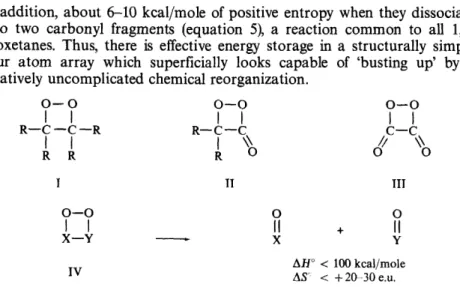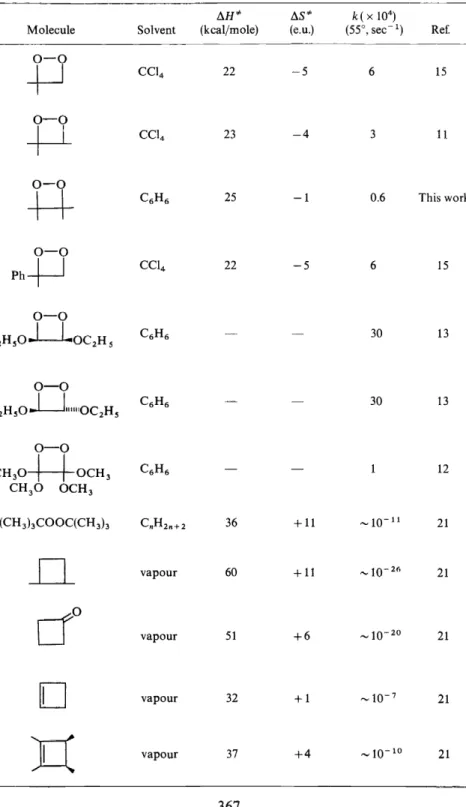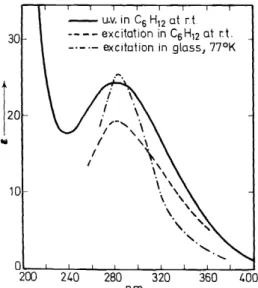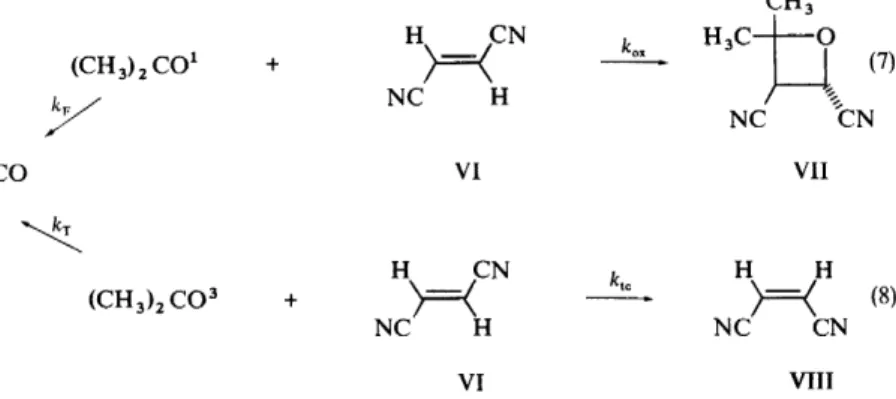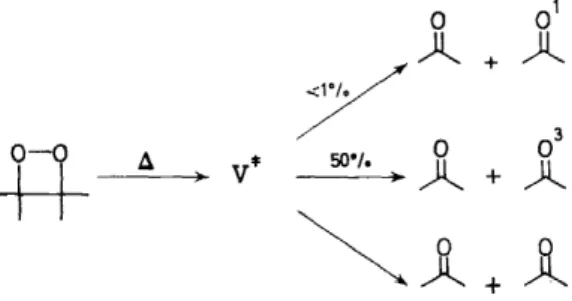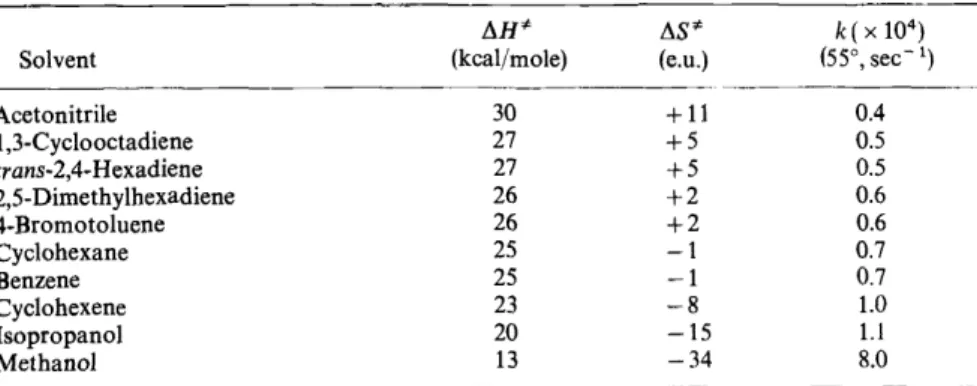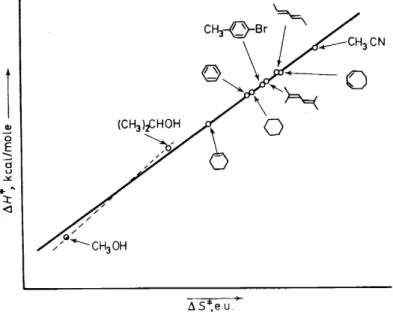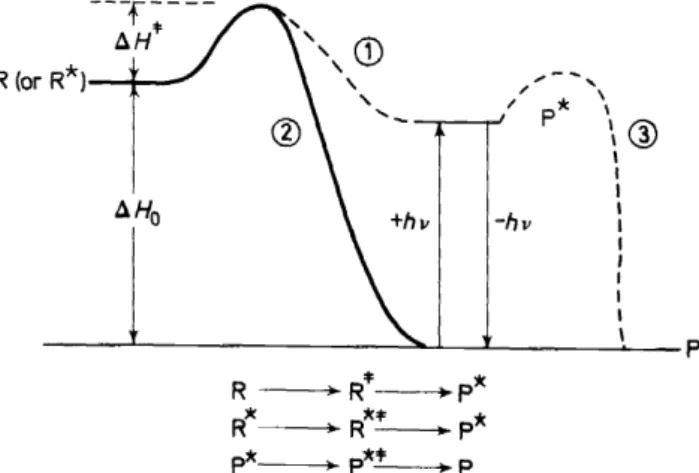THERMAL AND PHOTOCHEMICAL GENERATION OF ELECTRONICALLY EXCITED ORGANIC MOLECULES. TETRAMETHYL-1,2-DIOXETANE
AND NAPHTHVALENE
NICHOLAS J. TURRO and PETER LECHTKEN Department of Chemistry, Columbia University,
New York, NY 10027, USA
ABSTRACT
In this paper some examples of reactions which yield electronically excited products are presented. In particular, the 1 ,2-dioxetanes are discussed. These molecules cleave cleanly into two carbonyl fragments when heated or irradiated.
It will be shown that these simple, high energy, four atom arrays can efficiently generate electronically excited carbonyl fragments when they decompose.
Surprisingly, tetramethyl-1,2-dioxetane (V) yields acetone triplet selectively upon thermolysis or photolysis.
A study of the kinetics of thermal decomposition of V as a function of solvent, and the mechanistic implications of these observations will be dis- cussed. Based on summation of available evidence, we propose that the thermolyses of 1 ,2-dioxetanes require specific vibrational motions which enhance spin-orbit coupling as the molecule fragments, and allow efficient decomposition into triplet states.
In the photochemistry of V an exceptional 'anti-Stokes' sensitization is demonstrated, which suggests the possibility of efficient execution of 'blue light' photochemistry with 'red light', and a 'quantum chain' reaction.
It is demonstrated that, at 77°K, naphthvalene undergoes efficient photo- chemical conversion to naphthaJene triplets.
Finally, the relationship of radiationless electronic relaxation and primary photochemical processes is discussed in the framework of our results.
INTRODUCTION
In this paper we shall be concerned with organic reactions in solution that generate electronically excited products by either thermal (equation 1) or photochemical (equation 2) activation of reactants.
R .2._p* (1)
R~R*--P* (2)
Such reactions are of potential interest to photochemists, spectroscopists, kineticists and photobiologists for any number of reasons. Photoehemists may see in the study of such reactions a unique method of selectively produc-
363
NICHOLAS J. TURRO AND PETER LECHTKEN
ing electronically excited molecules which are not easily accessible by normal means of photochemical excitation. Spectroscopists may see in such reactions a connection between the ubiquitous and imperfectly understood radiation- less processes which interconvert the electronic states of a molecule and the change of electronic states implicit in reactions 1 and 2. Kineticists may be intrigued by the selective discharge, into specific groups of atoms, of sufficient chemical energy to produce an electronically excited product. Photobiologists, and the public at large, have long been fascinated by nature's display of chemielectronic pyrotechnics in fireflies and luminous plants, both of which are presumably manifestations of reaction 1.
In spite of the potential interest of reactions such as 1 and 2, hardly any information is available concerning the mechanisms of formation of electron- ically excited products. We hope this paperwill stimulate interest in this area by our discussion of several examples of reactions 1 and 2, which have been studied at Columbia during the last year or so. In particular, the thermal and photochemical reactions of tetramethyl-1,2-dioxetane have provided a well-suited system· for detailed study of reactions 1 and 2. In addition, the emission spectroscopy of naphthvalene also provides a particularly striking example of reaction 2.
ELECTRONIC STRUCTURE AND SPECTROSCOPY OF PEROXIDES
The outstanding property of the peroxide linkage is surely the feeble bonding which connects the two oxygen atoms, the 0 - 0 bond strength of organic per<)xides generally being less than 39 kcalfmole. This property of peroxides seems to originate in the repulsions of the non-bonded electron pairs on the adjacent oxygen atoms. A possible description of the highest energy electrons of the ground state of the peroxide bond is (nt0 )2, i.e. the mixing of two adjacent 11o orbitals causes splitting into a
n
00 andn&
pair,each of which is doubly occupied in the ground state1• The lowest available unfilled orbital is probably of cr~ character. Thus, the lowest energy electronic transition in simple peroxides can be characterized by rr1J0 --+ ot§0 . Essentially, instantaueaus cleavage of the 0--0 bond is clearly expected to follow electronic excitation.
Simplealkyl peroxides2 show only weak, nearly structureless end absorption in the region below 400 nm. For example, di-tert-peroxide2 possesses an inflection (e ,...., 5) at ,...., 260 nm. We are unaware of any systematic studies or reports of emission from alkyl peroxides3. Although sketchy, the Iiterature is consistent with the idea that the excitation
rrt
0 --+crt
0 results in dissociation or predissociation.PHOTOCHEMICAL REACTIONS OF PEROXIDES
Until recently, very little was known about the mechanistic details of the photochemistry of peroxides in solution. This situation probably results from the difficulty of direct excitation of peroxides, due to their inherently weak
· absorption above 250 nm. In spite of this, the recent work of Stor/" and Criegee5 has shown that some clever and important synthetic photoreactions
364
ELECTRONICALLY EXCITED ORGANIC MOLECULES
of peroxides can be achieved. For example, elegant syntheses of macrocyclic rings4 (equation 3) and cyclobutadienes5 (equation 4) have been achieved.
C l x f t l l CH3
I o
CI Cl CH3
hv hv
[ ClnCI]
Cl Cl+
+
0 0 II II
CH3COCCH3 (3)
(4)
Although no detailed mechanistic work on these n~actions has been reported, it seems reasonable to assume that the initial photochemical step is cleavage ofthe 0-0 bond, followed by secondary thermal decomposition.
This picture is consistent with the observation that di-tert-butyl peroxide mainly undergoes 0---0 bond cleavage when it is excited with ultra-violet light2.
Sensitized decompositions of peroxides have been reported3• 6, and it appears that triplet benzophenone can effect the decomposition of dibenzoyl- peroxide6. This experiment suggests, but does not require, that the peroxide linkage may 7 have triplets in the range of 70 kcaljmole.
Perhaps the spectroscopy and photochemistry of peroxides can be summarized as follows: not very much is known, but a Iot of interesting experiments remain tobe done.
1,2-DIOXETANES
1,2-Dioxetanes, given by the general structure I, have been the subject of intense recent study. Such structures have been implicated in many chemi- luminescent reactions8. et-Peroxylactones such as II and 111 are implicated in bioluminescent reactions9 andin a commercial method of producing cold light10 via a chemiluminescent reaction. The breakthrough, pioneering synthesis of trimethyl-1,2-dioxetane by Kopecky and Mumford 11 and the 1,2-addition of singlet oxygen to electron rieb and bindered ethylenes achieved by Foote and Mazur12, Bartlett and Schaap13, and the recent work of Adam et a/. 14, and Richardson15 et al., represent a monumental step forward for the study of intriguing, reactive but isolabte intermediates. The recent proposal that dioxetanes are intermediates in the ozonolysis of alkenes by Story16 may signal yet another breakthrough iit the synthesis of this family of remarkable cyclic peroxides.
These isolabte molecules are remarkable in that they are kinetically stable at 300°K, in spite ofthe fact that they release about 100 kcaljmole in heat and,
365
NICHOLAS .T. TURRO AND PETER LECHTKEN
in addition, about 6-10 kcaljmole of positive entropy when they dissociate into two carbonyl fragments (equation 5), a reaction common to all 1,2- dioxetanes. Thus, there is effective energy storage in a structurally simple four atom array which superficially Iooks capable of 'busting up' by a relatively uncomplicated chemical reorganization.
0 - 0
I I
R-C-C-R
I I R R
0-0
I I
X-Y
IV
0-0
I I
R-C-C
I ''
R 0
II 0 II
X +
0-0
I I
/;
c-c ,,
0 0
III 0 II
y ll.Ho < 100 kcal/mole ll.S' < + 20---30 e.u.
{5)
Reactions conforming to equation 5 are generally chemiluminescent, i.e.
enough energy is funnelled into a fragment so as to produce electronic excitation and eventual emission from that moiety. An extraordinary property has been proposed8 for molecules of type IV in this regard: that their decomposition can be catalysed by electronic energy acceptors!
Chemists who delight in the study of molecules possessing high energy content can not only probe into the reasons underlying the fantastic kinetic stability of 1,2-dioxetanes, but they can also design experiments to answer such questions as: (1) can a reaction be slow because it is too exothermic?
(2) is there a chemical equivalent to the Franck-Condon principle which prevents massive release of chemical energy into vibrational energy? (3) are orbital symmetry factors Operating? (4) what are the yields, multiplicities and mechanisms of formation of the electronically excited states responsible for the chemiluminescence in reactions of type 5? (5) can energy acceptors really 'catalyse' the decomposition of dioxetanes and if so, what is the mechanism of such an astanishing reaction?
SPECTROSCOPY AND PHOTOCHEMISTRY OF 1,2-DIOXETANES
Table 1 lists a number of 1,2-dioxetanes that have been reported in the literature. We shall discuss the kinetic parameters there listed later in this paper. The molecule, tetramethyl~ 1,2-dioxetane (V), is of special interest to us here, since it represents the only alkyl dioxetane which is expected to yield identical carbonyl fragments upon decomposition. Furthermore, our prior interests in the solution photochemistry of acetone allow us a splendid opportunity to search rationally for the electronically excited states of acetone when V is fragmented 1 7•
The exceptional electronic characteristics to be expected of 1,2-dioxetanes are apparent by simple visual observation of tetramethyl-1,2-dioxetane, which is a yellow, ,low melting solid. The ultra-violet absorption spectrum of
366
ELECTRONICALL Y EXCITED ORGANIC MOLECULES
Table 1. The kinetic parameters of some isolabte 1,2-dioxetanes and related systems llH"' !lS* k( X 104)
Moleeule Solvent (kcaljmole) (e.u.) (55°, sec-1) Ref.
o - o
+J
CC14 22 ~5 6 15o - o
-P
CC14 23 -4 3 11o - o
++
C6H6 25 -1 0.6 This worko - o Ph-i--J
CC14 22 -5 6 15
o - o
C2HsolloC 2H5 C6H6 30 13
0 - 0 C 2H50 . . . u111111ÜC2H5
C6H6 30 13
o - o
CH3o+-t-ocH3 C6H6 12
CH30 OCH3
(CH3hC00C(CH3h CnH2n+2 36 +11 ,..." 10-11 21
_0_
vapour 60 +11 -to-2" 21cf
vapour 51 +6 ,... 10-2o 21D
vapour 32 +1..., w-7
21n
vapour 37 +4 -10-10 21367
NICHOLAS J. TURRO AND PETER LECHTKEN
- - u.v. in C6 H12 at rt 30 ---- excitation in C6H12 at r:t.
-·- ·- excitation in glass, 77°K
10
0~~~--~~~--~~~--~~
200 240 280 320 360 1.00
nm
Figure 1. Absorption and excitation spectra of tetramethyl-1,2-dioxetane.
V is shown in Figure 1. The emission spectroscopy ofV is even more amazing in that at room temperature or at 77°K, photochemical excitation ofV results in the characteristic luminescence of acetone. The excitation spectrum of the acetone luminescence is consistent with the absorption spectrum of V (see Figure 1). Indeed, acetone luminescence {pure fluorescence) can be produced from V which is excited with light of wavelength as lang as 450 nm.
o-o
I I hvH3C -C-C-CH3 (6)
I I
H3C CH3
V
Product analysis demonstrated that the photolysis of V in benzene at room temperature Ieads quantitatively to two moles of acetone (equation 6).
Furthermore, the quantum yield for disappearance of V is 1.0. A question which immediately arises is: when singlet V, formed by direct absorption decomposes, what are the percentages of acetone singlet (A1) and triplet (A3) formed? In order to answer this question we need an experimentl probe which can quantitatively distinguish A1 and A3 and which also allows extrapolation to complete trapping of A1 and A3 . Such a method is available since A1 and A3 can be selectively 'titrated' with trans-dicyanoethylene (VI}
as shown in equations 7 and 8.
The key to this method of analysis is that VI yields completely differen1 products with A1 and A3 , namely the oxetane (VII) and cis-dicyanoethylenc:
(VIII), respectively. The photoreactions given in equations 7 and 8 an believed to be weil understood 17• Knowledge of limiting quantum yields fot formation of VIT and VIII allows measurement of the limiting yields of A 1
and A3 by simple extrapolation of a plot of the yields of VII and VIII (forme(
ELECTRONICALLY EXCITED ORGANIC MOLECULES CH3
___i:"_
H,Ct.t
(7)NC CN
+
H CN
>=<
NC H
y
(CH3) 2CO VI VII
~
H CN ktc H H<CH3 ) 2 C03 + NC
>=<
H NC>=<
CN (8)VI VIII
in the presence of decomposing V) to infinite concentration of VI, i.e. at infinite concentration kox[VI] ~ kF
+
ksT and k1c[VI] ~ kT, where kF and ksT are the rate constants for fluorescence and intersystem crossing, the important processes involved in deactivation of A1, andkr
is the rate constant for unimolecular decay of A3 (probably determined by a mixture of inter- system crossing and cx-cleavage). The results of our study with 366 nm excitation are given in Table 2. Unexpectedly, photochemical excitation of V results in preferential formation of A3. It should be emphasized that the approximate 4 to 1 preference for formation of A3 over A1 is not due to intersystem crossing of A 1, since the extrapolation to infinite concentration of VI means we have trapperl every A1 before intersystem crossing can occur.Table 2. Production of electronically excited acetone in the direct photochemical, and triplet photosensitized decomposition of tetramethyl-1 ,2-dioxetanea
Method
Direct photochemical
Triplet photosensitizede, r
Excited state yieldh Al
10 25 30 35
50
Excitation wavelength
366 nmc 320 nmd 297 nmd 240 nmd 436 nm
• One mole of excited acetone formed per mole of dioxetane decomposed is defined as 100 per cent, i.e. only one excited acetone is assumed to form per molecule of V decomposed.
b Percentage of excited acetone formed per mole of photons absorbed.
" At 6"C in benzene solution by titration with trans-dicyanoethylene. The 366 nm light is solely absorbed by the dioxetane under the applied conditions. <Pdisapp. = 1.0.
d · Determined by comparing dioxetane luminescence (pure acetone lluorescence) with that of acetone solutions of identical absorption at those wavelengths. Triplet yields not determined.
• Biacetyl sensitized at 6"C in benzene. See text.
r Measured by sensitization of the Type II cleavage reaction of valerophenone. See text.
Table 2 also shows the effect of excitation wavelength on the yield of A1•
A steady increase in the measured efficiency of formation is observed as the exciting wavelength decreases.
lt should be noted that the net efficiencies for formation of A1 and A3 at 366 nm apparently are less than unity. It is not absolutely clear whether this is due to a large experimental error or whether there is some real inefficiency in formation of electronically excited acetone.
369
NICHOLAS J. TURRO AND. PETER LECHTKEN
Dr Richard Hautala suggested an interesting method to test for an inter- mediate preceding the acetone fluorescence derived from direct excitation of V. He reasoned that the sensitive and precise method of single photon counting was eminently suited to detect such an intermediate, since the rise time of directly excited acetone fluorescence could be determined and com- pared to the rise time of acetone fluorescence derived from photoexcitation of V. Indeed, the two rise times were found to be identical with an experi- mental precision of the order of 0.1 x 10-9 sec! We interpret this result to require that no intermediate oflifetime greater than 10-10 sec precedes singlet acetone formation from singlet V, since such an intermediate would have caused a delay in the rise time of acetone fluorescence. This result, of course.
is consistent with the notion, mentioned earlier, that the electronically excited 0-0 bond is probably cleaved within a few vibrational periods.
PHOTOSENSITIZED DECOMPOSITION OF TETRAMETHYL-1,2-DIOXETANE: AN 'ANTI-STOKES'
TRIPLET EXCITATION TRANSFER
We have investigated the biacetyl photosensitized decomposition of V.
1t was immediately obvious that the phosphorescence, but not the fluorescence, ofbiacetyl is strongly quenched by V (k~ "" 107 M-1 sec-1). Are electronically excited states of V and/or acetone produced by this quenching? The answer is resoundingly positive, since sensitization of the decomposition of V by biacetyl triplets in the presence of valerophenone results in efficient sensitized Type II cleavage of the latter molecule. We calculate the efficiency of forma- tion of valerophenone triplets to be --50 per cent, based on an analysis of the data in terms of known kinetic schemes and an observed 30 per cent chemical yield of acetophenone!
Since the triplet energy of biacetyl is about 56 kcaljmole while that of valerophenone is 72 kcal/mole, sensitization of formation of valerophenone triplets by biacetyl triplets constitutes a formal example ofhighly endothermic 'anti-Stokes' triplet excitation transfer.
It thus seems that equation 9 is appropriate to describe the result of the interaction of biacetyl and V. The exothermicity of cleavage of V to two [CH,COCOCH,]3 +
n -· - )=o
3 +)=o
+ CH3COCOCH(9) 3)=o
3 +a0
IX)=o
+cf: I
(10)IX3
cfD
~I er
0 + 4'-.. (11)ELECTRONICALL Y EXCITED ORGANIC MOLECULES
acetones (ö.H "' -100 kcallmole) plus the triplet energy of biacetyl (E3 " ' 56 kcal/mole) makes the formation of two acetone triplets, equation 12, a formal possibility. However, triplet triplet annihilation and 'cage quenching' by biacetyl might reduce the efficiency of formation of 'free' acetone triplet. In this regard, it is interesting to note that the biacetyl which has sensitized the
deccmposition of a molecule of V does not efficiently quench the triplet acetone molecule which is formed Perhaps this indicates a long range quenching or a 'backside' displacement of the triplet acetone leaving group!
The efficient quenching ofbiacetyl triplets by V reminds us ofthe quenching of singlet states by strained molecules such as quadricyclane18 and hexa- methyl dewar benzene19• However, our sturlies have not progressed sufficiently for us to decide upon the details of the quenching mechanism.
We should point out, however, that Wilson and Schaap20 have proposed that triplet anthracenes sensitize the decomposition of cis-diethoxy-1,2- dioxetane, in order to explain the observation that oxygen 'protects' the dioxetane from an apparent induced decomposition in the presence of anthracenes.
The results reported here are quite preliminary and many studies remain to be done. Two very interesting types of experiments suggest themselves:
(a) generation of 'blue light' (or electronic excitation corresponding to absorption of blue light) by use of red light excitation (equations 13 and 14) and (b) a quantum chain mechanism (with equation 15 as a possible propaga- tion step).
sens
+
'red light'--+ sens*sens* + )=0*+
V--+ )=-O* + )=0 V--+2 )=0*+
)=o
THERMAL DECOMPOSITION OF TETRAMETHYL-1,2-DIOXETANE
(13) (14) (15)
As expected, heating of V in a variety of solvents results in quantitative formation of two moles of acetone (equation 16). Kopecky and Mumford11 had reported earlier that trimethyl-1,2-dioxetane is chemiluminescent. Other
0-0
I I
H3C-C-C-CH3
I I
(16)H3C CH3 V
examples of chemiluminescence concomitant with dioxetane decomposition have been observed12• 1
4-16• 20
. White demonstrated that trimethyl-1,2- 371
PAC-33-2-H
NICHOLAS J. TURRO AND PETER LECHTKEN
dioxetane could sensitize the triplet reactions of a nurober of acceptors22, with net efficiencies of up to about five per cent. Wilson and Schaap20 sug- gested that the dioxetane X yields ethyl formate singlets in high, possibly quantitative yield. Güsten and Ullman23 proposed that Ill is the active species in an oxalate-peroxide sensitized reaction, with net reaction effic- iencies approaching five per cent in favourable cases. Chemiluminescence from XI and XTI have been observed during their thermolysis.
H H
X
o-o
I ICH30-C-C-OCH3
I I
CH30 OCH3 Xl
o-o
I I<eH> c-c-c 3 3 ~ I o
H
xn
These results leave little doubt that electronically excited states are produced upon decomposition of 1,2-dioxetanes. However, the precise nature of the electronically excited species and their mechanism(s) of forma- tion have not been defined. Let us now consider how the mechanism of decomposition of V was elucidated.
It has already been noted that the reactions of singlet and triplet acetone with trans-dicyanoethylene yield the oxetane
vn
and cis-dicyanoethylene VIII, respectively, as the exclusive products24. lt is possible to titrate simul- taneously A1 and A3 with trans-dicyanoethylene as they are produced from the thermolysis of V. The limiting yields25 of A1 and A3 from thermolysis of V are reported in Table 3. We are immediately confronted with the rather startling result that, based on titration with VI, the thermolysis of V yields A1 in less than one per cent while the yield of A3 is about 50 per cent! An unexpected result of this type requires independent and convincing confirma- tion before it can be considered as valid. However (Table 3), the same yields of A1 and A3 were measured, within experimental error, (1) by measurement of the chemiluminescence (pure acetone fluorescence) of V; (2) by sensitiza- tion of biacetyl fluorescence and phosphorescence; (3) by chemical titration with cis-diethoxyethylene. Thus, the evidence is quite compelling that V has a preference for decomposing into A3 rather than A1 (Figure 2).We were able to show beyond any reasonable doubt that acetone singlets, rather than some other reactive species (like, say, the dioxetane itself), attack
0 01
Ä+ Ä
7
03++
A v* fiJ"/. 0Ä+ Ä
~Jl+ Jl
Figure 2. Thermolysis of tetramethyl-1,2-dioxetane.
w
-.J w
Table 3. Production of electronically excited acetone from the thermolysis of tetramethyl-1,2-dioxetanea
Method Titration with VI
Absolute fluorescence actinometryr Titration with biacetyl
[Dioxetane Jh
1.07 M 0.1 M 0.02M
tP (Chemical)c%
Oxetane 0.02
lfJ(Photo)d%
Isomerization Oxetane Isomerization Singlet
5 8 10 0.3
0.2 0.8
lfJ(A*)e%
Triplet 50 50
• Thermal decomposition ofVat 70°C in benzene. It follows first order kinetics (k = 4.05 x 10-4 sec-1 at 71°). Tbe samerate is found for decomposition ofVand disappearance ofchemiluminescence at the maximum 404 nm. Error Iimits are estimated to be of the order of ±50 per cent.
b Actual runs. Variation of the concentration ratio [Dioxetane ]/[ quencher] from 2: 1 to 1 :2 had no significant effect. Averages: 0.2 per cent singlet, 50 per cent triplet per mole of dioxetane decomposed.
• Percentage product formation per mole of dioxetane decomposed. Singlets form oxetanes, triplets give rise to isomerization.
d Limiting quantum yields. See ref. 24 for details.
• ifl excited = iflchem/4iphoto.
r Absolute actinometry, using ferrioxalate. See J. N. Demas, G. A. Crosby, J. Phys. Chem. 75,991 (1971).
' Extrapolated to infinite concentration of biacetyl.
ti:I t""" ti:I (') ...,
:::a 0 z
-
(') >
t""'.
t""''
><:
ti:I
><
-
(') ..., ti:I0 0 :::a 0 >
z ()
~ 0
ti:I r
(') c::
r ti:I ti'J
NICHOLAS J. TURRO AND PETER LECHTKEN
t-DCE. This was done by demonstrating that Stern-Volmer quenching of the chemiluminescence of V by t-DCE (benzene solution) yields the same slope (k9 -r) as that obtained from quenching of acetone fluorescence by t-DCE25.
Incidental to this study we noticed that high concentration of V decreases the net yield of A3, indicating that Visa quencher of A3 . Consistent with this possibility is the observation that degassed solutions show less chemilumines- cence than aerated solutions. We interpret this result as follows: since oxygen is known to be an efficient q uencher of A3 but not A 1, oxygen protects V against sensitized decomposition by A3 (which apparently does not generate A1 ), thereby allowing more molecules of V to form A1 (the state responsible for chemiluminescence). This result is the basis of our earlier conclusion that quenching of biacetyl triplets by V does not generate A1 •
In addition to the remarkably efficient and selective formation of A3 relative to A1, we wish to point out that the blue (acetone fluorescence) chemiluminescence is a 'red herring' with respect to the major method for excited state production from V. This shows the hazards of making mechanis- tic conclusions solely on the basis of low efficiency chemiluminescence.
Finally, V is a 'self quencher' of chemielectronic production of A3, while dissolved oxygen is a 'promoter' of chemiluminescence. We conclude that low concentrations of V in the absence of oxygen (i.e. under conditions that chemiluminescence is decreased) are most favourable for efficient production of chemically useful excited states (triplets) from V.
ACTIVATION PARAMETERS FOR THE DECOMPOSITION OF TETRAMETHYL-1,2-DIOXETANE. SOLVENT EFFECTS In order to gain further insight concerning the mechanism of thermolysis of V, the activation parameters for fragmentation were measured. Since the rate of decomposition of V is directly proportional to the rate of formation of acetone singlets, which is in turn directly proportional to the chemilumines- cence intensity, therefore the kinetics for decomposition of V are easily followed by the sensitive and precise method of fluorimetry. The activation parameters for decomposition ofV in several solvents are listed in Table4. There
Table 4. Solvent dependence of the activation parameters for thermal decomposition of tetra- methyl-1,2-dioxetane
llH* llS* k( X 104)
Solvent (kcal/mole) (e.u.) (55°, sec-1)
Acetonitrile 30 + 11 0.4
1 ,3-Cyclooctadiene 27 +5 0.5
trans-2,4-Hexadiene 27 +5 0.5
2,5-Dimethylhexadiene 26 +2 0.6
4-Bromotoluene 26 +2 0.6
Cyclohexane 25 -1 0.7
Benzene 25 -1 0.7
Cyclohexene 23 -8 1.0
lsopropanol 20 -15 1.1
Methanol 13 -34 8.0
1
~ 0 E ::::
d V ..Y:.
....
::t
<l
ELECTRONICALL Y EXCITED ORGANIC MOLECULES
0 \
ßS~e u)
Figure 3. Correlation of ßH* and ßS* for the thermolysis of tetramethyl-1,2-dioxetane in various solvents. The two alvohols studied appear to fall on a separate line.
t,
is a rather large spread in th{values of
~H*
and~S*
in different solvents.However, a rather good strajght line is achieved when ~H* is plotted versus
~S* (Figure 3). This plot is Jh.us evidence for an isokinetic relationship26, i.e.
~H* = ß~S*, where ß is;the isokinetic temperature, equal to 86° in this case. The occurrence of an/isokinetic relationship is consistent with one major interaction mechanism in ,fhe thermolysis of V26. Alcohols (Figure 3) do not adhere strictly to the relationship, however.
The integrated chemiluminescence intensity <PcL is proportional to the yield of A1 in the thermolysis of V. Significantly a plot of In <P CL versus the activation energy f91 decomposition of V in different solvents yields a straight line (Table 5)~/ This result suggests that the mechanism involving formation of A1 is rel;~ted to the major decomposition path.
The work of Ricll~rdson and O'NeaP5
has
shown that the activation parameters for the ~ecomposition of the dioxetanes XIII and XIV in carbon tetrachloride are experimentally indistinguishable (Ea=
23.0 kcaljmole,Table 5. Solvent dependence of chemiluinescence from tetramethyl-1,2-dioxetane
Solvent A.H* IPcL a
(kcallmole) %
Acetonitrile 30 0.28
Benzene 25 0.20
Cyclohexene 23 0.13
Ethanol 16b 0.07
• Chemiluninescence yield determined by integration ofthe corrected acetone lluorescence observed during thermo Iysis of V. T equals 69°.
b Estimated from the values for methanol and isopropanol. See Table 4.
375
NICHOLAS J. TURRO AND PETER LECHTKEN
llH*
=
22.4 kcaljmole; log A = 12.2, llS* = -5 e.u.). They interpreted these data as evidence for a two-step mechanism, in which the key energetic and structural feature required to reach the transition state is breaking of the 0-0 bond. In a concerted mechanism the phenyl group would be expected to interact differently from the methyl with respect to the develop- ing carbonyl bond (as has been suggested to be the case in fragmentations of alkoxy radicals). In agreement with their premise, these authors showed that calculated activation parameters, based on a two-step mechanism with rate-determining formation of a biradical intermediate, were in good agreement with their experimental data.XIII XIV
REACTIONS WHICH PRODUCE PRODUCTS IN AN ELECTRONICALLY EXCITED STATE OR WHICH UNDERGO
A CHANGE IN ELECTRONIC STATE
Some fundamental and thought-provoking ideas should be considered before the possible detailed mechanisms for photochemical and thermal decomposition ofV are explored; namely, the concepts of chemical reactions which undergo a change of electronic state along the reaction profile and/or chemical reactions which produce products in electronically excited states.
These ideas are shown schematically in Figure 4. In this diagram the con- version R ~ P* and R* ~ P* are changes in state which produce an electro- nically excited product (electronic excitation denoted by
*
and vibrational excitation by # ). The conversion R* ~ P* is a radiationless process in which a change of electronic state must occur somewhere along the reaction coordi----r----
t:t.H~
... --.,
/1'
* \
_ _ _, p
\®
I I I
-hv :
I I I I I
----~---~~~~----~'---P R ~ R*---+--p*
R*---+ R*~ p*
p*~p*~p
Figure 4. Schematic description of processes involving formation of products in electronically excited states.
ELECTRONICALL Y EXCITED ORGANIC MOLECULES
nate. In effect, all photoreactions involve at least one radiationless process before a final, ground state product is formed.
Radiationless electronic excitation and de-excitation are generally classi- fied as 'physical' processes if these processes occur within the framework of the electronic states of a single molecule. Hammond27 has convincingly pointed out that such a classification is not fundamentally required. He has indicated that such a classification may violate our most deep-seated intuitive notions in certain cases such as collapse of a perpendicular ethylene to cis and trans-isomers: the physical or chemical nature of the process would depend on the structure of the starting olefin! Indeed, one can perhaps better support a radically different point of view, namely that all electronically excited states are electronic isomers of the ground state, thus all electronic state interconversions involving at least one electronically excited state are chemical in nature. This view of things would logically include radiative processes where, in absorption, the photon is a reagent and, in emission, the photon is a product. An advantage of this attitude is that organic photo- chemistry then broadens, in a natural way, its purview to include all reactions which interconvert electronic states, whether or not light is involved in any of the excitation andjor de-excitation processes. The 'photo' part simply means that light happens to be the most convenient general way of producing or detecting an electronically excited state. Now Iet us return to Figure 4.
The process R* --+ P* might be (a) an intramolecular excited state inter- conversion such as 82 --+ 81,81 --+ T 1, etc. or (b) an excited state interconversion such as V* --+ A1
+
A0 or V*--+ A3 + A0 , in which electronically excited states of a molecule different from R are generated. The process R ~ P*Ieads to an electronically excited state from a ground state starting material.
1he electronically excited product is identical in all cases to the species produced by light excitation, i.e. hv + P --+ P*: Furthermore, it seems sensible to try to treat analysis ofthe mechanism ofthe process R --+ P*in a manner analogaus to the treatment of the P*--+ P* process. This frame of reference is easily extended to the cases in which P* undergoes a proreaction itself, to yield a product P'.
Nowwealsocanseethatchemiluminescence,theprocessR--+ P*-+ P + hv, is simply a specific corollary of the more general theory of generation of products in electronically excited states.
The theory of radiationless transitions and chemical reactions can be treated under the general concept of electronic relaxation. The available theories of radiationless transitions may, therefore, provide a source of useful and refreshing ideas and langnage to discuss rate processes. 8ome of the connections between the usual manners in which an organic ehernist and a spectroscopist might discuss electronic relaxation processes can be gathered from a comparison of the familiar28• 29 equations 17 and 18. Instead of the usual attempts to evaluate AH* and AS*, the key conceptual quantities of transition state theory (the model of kineticists), we shift to dynamic
rate oc exp ( -AH* /RT) x exp (AS* /R) rate oc
(t/liiHitJ!r>
2 "'<tfJdHiif1r>
2<xdxr>
2AEi1 AE;1
377
(17)
(18)
NICHOLAS J. TURRO AND PETER LECHTKEN
perturbation theory (equation 18) for consideration of conversion of electronic energy into nuclear motion (vibrational energy) as we pass from the 'transition state' (1/1*) to upper vibrational states of the product
(1/!j).
This theory is thus essentially vibronic in nature. The important, usable concepts in equation 18 are the electronic matrix element ( c/J;IHI€/J 1 ), the vibrational overlap integral (X;Ix1 ) and the energy gap between the inter- acting states. With the exception of the vibrational overlap integral, equation 18 is the basis for the orbital symmetry30• 31 rules in which specific nuclear motions and electronic interactions are expected tobe particularly favoured in concerted reactions, i.e. the 'best' electronic interactions between 1/1 i and t/J.r are vibrationally induced. Certainly, many organic photochemists will not find equation 18 to be a comfortable andjor comprehensible theoretical framework in which to discuss rate processes. Yet we are all probably familiar enough with orbital language to commonly write down pretty pictures of overlapping Iobes in order to rationalize our observations. Perhaps the important feature of equation 18 of general impact is that, in addition to the expected electronic overlap term and symmetry considerations, new possi- bilities for H come to mind, and the initial vibrational motions which couple
I/li
andI/Ir
are emphasized. Weshallsee in the discussion of the mechanism of decomposition of V, that we can profitably make good use of the ideas suggested by equation 18 to infer some fascinating detail about bond- breaking processes; and gain some insight into how V is able effectively to store so much energy, in spite of the apparently simple electronic reorganiza- tion which could release an enormous amount of free energy.MECHANISMS FOR ffiE PHOTOCHEMICAL AND THERMAL DECOMPOSITION OF TETRAMETHYL-1,2-DIOXETANE Let us summarize the prominent features of the photochemical and thermal decomposition of V which must be handled by any mechanism: (a) two molecules of acetone are produced per molecule of V decomposed under all conditions which were studied; (b) the formation of triplet acetone is favoured over that of singlet acetone under both photochemical and thermal excitation of V; ( c) the solvent dependence of the activation parameters for thermolysis of V reveals an isokinetic relationship; (d) hydroxylic solvents do not adhere strictly to the isokinetic relationship; (e) the formation of electronically excited products from V is not completely efficient in either its · thermolysis or photolysis;
<n
the activation parameters for decomposition of other 1,2- dioxetanes do not depend much on structure.First Iet us attack the mechanism of the thermal reaction in non-polar . solvents, e.g. benzene, cyclohexane or carbon tetrachloride. The activation parameters in such solvents are llH* .- 23 to 25 kcaljmole and llS* '""" -1 to -5 e.u. Cantrastthese values with those for decomposition of di-tert-butyl peroxide (equation 19) and fragmentation of a cyclobutane (equation 20).
The lower enthalpy of activation of V relative to acyclic alkyl peroxides can be taken care of in any mechanism by invoking ring strain, which is estimated as about 26 kcaljmole15. However, the low, slightly negative, value of llS* for V and other dioxetanes (Table I) suggests that either the
ELECTRONICALL Y EXCITED ORGANIC MOLECULES
(CH3hCO-OC(CH3h -11~·---+ 2(CH3hCO·
!J.H"* "" 35 kcal/mole
0
I!!S"* + 10 e.u.
II
11H* ,...., 60 kcal/mole
!1S"* ,....,
+
10 e.u.+ II
(19)
{20)
starting material has not gained a substantial increase in flexibility, or has a low probability in reaching to the transition state, or that some ordering of solvent is required. The latter seems unlikely to be important in cyclohexane.
Several specific proposals to explain the t1S* values are (a) the 0 - 0 bond breaks but reforms, thereby achieving the transition state, but not proceeding on to product; (b) achievement of the transition state requires a change in electronic state30, i.e. a singlet to triplet conversion, or a conversion of a massive amount of chemical energy into vibration energy, such as formation of two vibrationally excited acetone molecules; (~) specific restrictive molecular motions are required to achieve the transition state.
As we have seen, there is convincing evidence that the 0-0 bond is nearly fully broken in the transition state, i.e. the transition state is 'biradical like' in character, since the activation parameters for thermolysis are structure- insensitive and because a biradical model for the transition state allows accurate calculation ofthe activation parameters15. What about the possibility then, that the biradical forms but then recollapses to dioxetane? We cannot think of any rigorous way to rule this possibility out; however, the reverse reaction should have an activation energy of about 8-10 kcal/mole15. The cleavage ofthe carbon-carbon bond should be quite facile from the biradical, since Ea for fragmentation of a methyl group from the tert-butoxy radical is only .._ 15 kcallmole21. Since the activation energy for ß-cleavage of butoxy radicals decreases as the stabilization of the leaving group increases31, the biradical XVII may weil have an activation energy for cleavage much less than 8 kcal/mole. Furthermore, fragmentation should be increased in rate in a solvent like cyclohexene, if we use tert-butoxy radicals as a model, since Walling and Wagner32 found that cyclohexene had a profound effect of enhancing cleavage of alkoxy radicals over other modes of decomposition.
ö >=o*
0 - 0 0
++ -H-
+ (21)XVII
>=o
The second explanation, i.e. that a singlet-triplet conversion is required in going to the transition state, is particularly intriguing. The reaction N20---+
N2 + 0 is believed to be an example of such a non-adiabatic process33•
379
PAC-33-2-I
NICHOLAS J. TURRO AND PETER LECHTKEN
However, no well documented examples of organic reactions which follow such a reaction surface are known, although cis-trans isomerization of certain ethylenes was once thought to conform to this model33. In any case, the lack of a heavy atom effect (4·bromotoluene falls on the isokinetic line) and the rather large positive value of fl.S* in acetonitrile suggests that the spin flip required to obtain the major product, acetone triplet, occurs after the transition state is achieved, for all intents and purposes.
[ 0~::::::/ r )=o3
++ o-o
!!)=o
+ (22)The possibility of a conversion of a massive amount of electronic energy into vibrational energy seems intuitively unreasonable, i.e. a violation of the chemical equivalent of the Franck-Condon principle (the nuclear factor in equation 18 is very small). However, we must admit that our results suggest that some fraction of V may, in fact, follow such a path.
Weshall now show that the third mechanism, in which specific molecular motions are required to achieve the transition state, is consistent with the observed fl.S* values, and furthermore, has the ability to correlate the other observations quite satisfactorily.
The most obvious types of nuclear motion, which might be more restrictive in V* than in the ground state, are those in which pendant groups are caused to interfere with one another in achieving V*, thereby reducing vibrational and rotational freedom. Arguments based on this attitude have severe difficulties when confronted with the data on activation parameters given in Table 1. Certainly, if eclipsing effects were operating to cause the low activation entropies, we would expect a wide variation in fl.S* which should decrease with increasing encumbrances due to pendant groups on the carbon atoms. In fact, the most bindered dioxetane for which a value of ßS* is available, namely V, has the highest value of ßS*. Note, however, the increase in öH* as one proceeds from the 3,3-dimethyl (XIII) to trimethyl (XIX) to tetramethyl dioxetanes.
lf
this effect is ascribed to destabilizing interactions between pendant groups in the transition state, there cannot be much entropy loss associated with the group interactions. Note, moreover, that in a 'classic' case of a biradical fragmentation, namely, fragmentation of 1,2-dimethyl- cyclobutane [into two molecules of propylene (Table 1)], the values of ßS*are highly positive (
+
11 e.u.)! Furthermore, cis-1,2,3,4-tetramethylcyclo- butene (XX) provides a good model for what to expect when two methyl groups are compelled to rotate as a transition state is approached. Notice that for XX relative to cyclobutene, fl.H* increases (by 5 kcaljmole) and ßS*increases (by 3 e.u.) while for XIII relative to V, öH* increases (by 4 kcaljmole) and ßS* increases (by 4 e.u.)! Since the thermal ring opening ofXX is conrota-
tory, the methyl groups have a very specific motion which achieves the transi- tion state. The disrotatory motions are not productive in forming the lowest energy transition state. The above discussion suggests to us that a close rela- tionship may exist between the 'classical' concerted ring opening of cyclo-
380
ELECTRONICALLY EXCITED ORGANIC MOLECULES
butenes and the ring opening of dioxetanes. Indeed, in the one example of solvent effects on the activation parameters for ring opening of cyclobutenes, we have been able to locate in the literature21, an apparent isokinetic relation- ship holds! Let us now follow up this line of thinking a bit more closely.
Consider the cleavage of the 0-0 bond of V as being nearly complete in the transition state V* and then consider the final product, triplet acetone (equation 23). Notice that a 90° rotation of the bonding lobe on the left band
d:
(23)V* A3 Ao
oxygen generates the final n, n* state. Furthermore, this electronic motion is formally analogaus to that required for maximal spin orhital coupfing in a molecule so that the normal prohibition to spin interconversion is expected to be substantially lowered34!
That this should be the case can be easily demonstrated to anyone who believes that 1n, n* +=! 3n, n* spin interconversions are allowed relative to
1n.n* p: 3n, n* and 1n, n* P' 3n, n* interconversions. Equation 23 shows pictorially how the formal mathematical operation of the spin orbital coupling operator34 corresponds to the motion of a p-like orbital through 90°, and is thereby theoretically connected to the type of motion which con- verts V* into A3 and A0! We note that it is the initial nuclear motions which probably are important here, in the same way that one must suppose that initial nuclear motions dominate the rates offormation oftransition states for photoreactions which adhere to orbital symmetry30• 31
rules, e.g. electro- cyclic ring openings and closures. Thus, an idea which has long been part and parcel of the theory of state interconversions used by molecular electronic spectroscopists34 may now be applied in a very intriguing way to help under- stand the mechanism of decomposition of an organic molecule, i.e. the con- version of V* to A3 + A1 is a vibrationally induced intersystem crossing.
Carrying this idea a bit further, we can understand the wide range of t1H*
and t1S* values on the basis of a mechanism which involves a transition state which is biradical-like in character, but which requires a 'twist' motion of the fragmenting sigma orbital of the 0-0 bond. Let us consider the values of t1H* and t1S* in cyclohexane, and assuming the solvent effect to be negli- gible here, the t1H* value (25 kcal/mole) represents a value for breaking the 0-0 bond and the t1S* value ( -1 e.u.) represents a loosening of molecular motions as the 0-0 bond breaks (increase in entropy) but also a specific kind of motion as shown in equation 23 ( decrease in entropy) thereby leading to a nearly zero value for t1S*. The breaking of the 0-0 bond can be assisted by charge transfer stabilization ofthe transition state by the solvent (cyclohexene, t1H* = 23 kcalfmole). This is quite analogaus to the effect observed by Walling and Wagner32 on the fragmentation ofalkoxy radicals. These authors
381
NICHOLAS J. TURRO AND PETER LECHTKEN
found that cyclohexene solvent has a marked effect which strongly favoured
ß-
scission (equation 24) over hydrogen abstraction. There is an entropy price to be paid, in this mechanism, and we note that indeed fl.S* becomes more negative (- 8 e.u.) than the value in cyclohexane. Hydrogen bonding might also be expected to assist cleavage of the 0-0 bond in analogy to the results of Walling and Wagner32. Indeed, fl.H* is much lower in isopropanol (20 kcallmole) and drops further (to 12 kcaljmole) when the more acidic, less bindered molecule, methanol is solvent. The entropy price paid here is mainly due to tying up the solvent in specific orientations and is more costly
(~S* = - 15 e.u. and -34 e.u., for isopropanol and methanol, respectively).
R@ I R-C-ü•@
R@ I
R@ I
R-C-0·@
R-C-0·@
Ik®
.<5
R®
I .<5R---c--u ®
I .
R@
R-~---0@
f*®
I
R-c-==o
®
k®
(24)
(25)
One may now ask the question, is there any 'linear-type' of cleavage of the 0-0 bond? We have no good arguments for its specific occurrence, but perhaps the fragmentation of V into singlet states (A1
+
A0 or 2A) involves such a cleavage. It is interesting to note, in this regard, that as the activation energy rises, the relative yield of A1 + A0 increases (Table 5).With respect to the photochemical decomposition of V, we do not have sufficient data for a detailed mechanistic picture. It seems reasonable, however, to suppose that the 0-0 bond would be cleaved easily in the excited states of V. The factors determining ratio of singlet and triplet yields are a bit more difficult to assess now, since they may reflect the rate of intersystem crossing of V(S1) rather than the rates of direct partitioning of V(S1) into A1 and A3 • The wavelength dependence is consistent with either view, if we hypothesize that higher excitation energy favours V{S1) -+ A1
+
A0, with respect to intersystem crossing which eventuates in V{T 1)-+ A3+
A0 • The faster rate of cleavage ofT 1 relative to S1 has a possible analogy in the observation that n,n*
triplets of alkanones undergo cx-cleavage at a much faster rate than n, rr*singlets17•A SEARCH FOR CATALYSIS OF FRAGMENTATION OF V BY ENERGY ACCEPTORS
One of the possible reasons for the remarkable stability of dioxetanes has been put forth in the previous section. Let us now consider the fascinating
382
ELECTRONICALLY EXCITED ORGANIC MOLECULES
question: can an electronic or vibrational energy acceptor 'catalyse' the fragmentation of dioxetanes by (a) diminishing the problern of conversion of substantial amounts of chemical energy into vibrational energy, i.e. equation 26 or (b) by providing a path for a 'non-classical' electronic energy from a
+-+
0-0 + Q 2)=o
+ (26)ground state donor to produce an electronically excited acceptor, i.e. equation
27.
o-o
++
+ Q 2)=o
+ Q* (27)Both these mechanisms, if they are elementary reactions, will require some electronic coupling or complexing for reaction to occur efficiently. Thus, the rate offragmentation ofV may suffer from an increase in 11G* due to a more negative 11S*. We should thus search for catalysis by analysing 11H*.
Before doing so, Iet us pointout that Rauhut8• 37 suggested some time ago that the decomposition of 111 might be catalysed by certain aromatic com- pounds (e.g. anthracenes) in order to explain enhanced decomposition rates in some chemiluminescent reactions. He8 also suggested that the acceptor is behaving as an electron donor in these catalyses so that the ionization potential of the acceptor might be important in determining the effectiveness of a catalyst. Mazur and Foote12 have reported the apparent catalysis on tetramethoxy dioxetane by zinc tetraphenylporphine. Kopecky and Mum- ford11 found that 0.2 M biacetyl increases the rate of decomposition of tri- methyl-1,2-dioxetane by a factor of nearly two. However, Wilson and Schaap20 have shown that enhanced rates of decomposition may be due to energy acceptors, relaying their newly acquired electronic excitation energy to a ground state dioxetane, thereby causing its 'sensitized' decomposition. Thus, the role of any real 'catalysis' by added energy acceptors is not fully established.
We have measured the activation parameters for thermal decomposition of benzene solutions V in the presence of energy acceptors (Table 6). In each case, the fluorescence of the acceptor20• 38 was excited by decomposing V.
Table 6. Activation parameters for thermolysis ofbenzene solutions of tetramethyl-1 ,2-dioxetane
Acceptora None Ruhrene 9,10-Dimethyl-A 9,10-Dibromo-A 9,10-Dichloro-A 9,10-Diphenyl-A
r in the presence of energy acceptors
25 26 31 28 27 20
!:J.S*
(e.u.) -1 +0.5 +16 +8 +4 -16
1.3 1.0 0.5 0.6 1.1 2.2
0.4 1.0 120
4.3 0.6
• A denotes anthracene; 0.01 M in benzene, aerated solutions. Ratio acceptorjdioxetane = 1:2.
0.01 0.25 0.9 0.45 0.16
b Relative chemiluminescence yields, corrected for the relative fluorescence quantum yields under the applied conditions (69°
in benzene).
383
